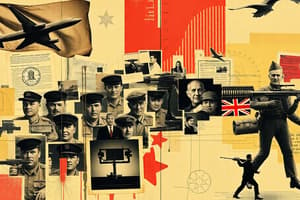Podcast
Questions and Answers
What is the primary means by which Army forces apply land power?
What is the primary means by which Army forces apply land power?
- Combat power (correct)
- Decisive action
- Stability tasks
- Information Operations
Information Operations is solely categorized as an offensive task.
Information Operations is solely categorized as an offensive task.
False (B)
What are the three enabling activities that commanders and staff undertake to support decisive action?
What are the three enabling activities that commanders and staff undertake to support decisive action?
Analyze and depict the information environment, determine IRCs and IO organizations available, optimize IRC effects.
The continuous combination of offensive, defensive, and stability tasks is known as _______.
The continuous combination of offensive, defensive, and stability tasks is known as _______.
Match the weighted efforts with their corresponding focus:
Match the weighted efforts with their corresponding focus:
IO weighted efforts help to optimize the integration of IRCs in the information environment.
IO weighted efforts help to optimize the integration of IRCs in the information environment.
What is the main objective of using IO in decisive action?
What is the main objective of using IO in decisive action?
What role does IO play in supporting the concept of operations?
What role does IO play in supporting the concept of operations?
Which of the following describes an attack orientation in the information environment?
Which of the following describes an attack orientation in the information environment?
Creating ambiguity or confusion is a form of stabilizing effort in the information environment.
Creating ambiguity or confusion is a form of stabilizing effort in the information environment.
What is the primary goal of an information operation (IO) effort with a stabilize orientation?
What is the primary goal of an information operation (IO) effort with a stabilize orientation?
The cognitive dimension of information operations focuses on creating support for _____ and local security forces.
The cognitive dimension of information operations focuses on creating support for _____ and local security forces.
Which of the following is NOT typically synchronized to achieve attack orientation in the information environment?
Which of the following is NOT typically synchronized to achieve attack orientation in the information environment?
Match the following IO efforts with their corresponding objectives:
Match the following IO efforts with their corresponding objectives:
Overconfidence in false signals can aid defensive strategies.
Overconfidence in false signals can aid defensive strategies.
What is one way to align Soldier actions with their words and images?
What is one way to align Soldier actions with their words and images?
Which of the following is NOT included in the physical dimension of a defend orientation?
Which of the following is NOT included in the physical dimension of a defend orientation?
Operations security (OPSEC) is an example of an information operation that can be synchronized to achieve a defend orientation.
Operations security (OPSEC) is an example of an information operation that can be synchronized to achieve a defend orientation.
What primary effect does an attack orientation seek to achieve in the information environment?
What primary effect does an attack orientation seek to achieve in the information environment?
In the informational dimension, a common practice to counteract attacks is to use ______ to protect data.
In the informational dimension, a common practice to counteract attacks is to use ______ to protect data.
Which of the following is NOT a recommended practice in the cognitive dimension of defend orientation?
Which of the following is NOT a recommended practice in the cognitive dimension of defend orientation?
The information environment effects from a defend orientation might include ______ to determine sources of attack.
The information environment effects from a defend orientation might include ______ to determine sources of attack.
Match the following efforts with their associated orientations:
Match the following efforts with their associated orientations:
Name two IRCs that can be synchronized to achieve an attack orientation.
Name two IRCs that can be synchronized to achieve an attack orientation.
Flashcards
Physical Dimension (Defend)
Physical Dimension (Defend)
Actions taken to protect physical resources and personnel from harm during Information Operations (IO) efforts.
Informational Dimension (Defend)
Informational Dimension (Defend)
Steps to safeguard information and communication systems in a defensive IO stance.
Cognitive Dimension (Defend)
Cognitive Dimension (Defend)
Protecting information, ensuring access to data, and using knowledge management principles for defensive IO.
IO Weighted Effort: Attack
IO Weighted Effort: Attack
Signup and view all the flashcards
Physical Dimension (Attack)
Physical Dimension (Attack)
Signup and view all the flashcards
Informational Dimension (Attack)
Informational Dimension (Attack)
Signup and view all the flashcards
Synchronized IRCs (Attack)
Synchronized IRCs (Attack)
Signup and view all the flashcards
Cognitive Dimension (Attack)
Cognitive Dimension (Attack)
Signup and view all the flashcards
Information Operations (IO)
Information Operations (IO)
Signup and view all the flashcards
Decisive Action
Decisive Action
Signup and view all the flashcards
Enabling Activities for IO
Enabling Activities for IO
Signup and view all the flashcards
IO Weighted Efforts
IO Weighted Efforts
Signup and view all the flashcards
IO Weighted Effort: Defend
IO Weighted Effort: Defend
Signup and view all the flashcards
IO Weighted Effort: Stabilize
IO Weighted Effort: Stabilize
Signup and view all the flashcards
Combat Power and Information
Combat Power and Information
Signup and view all the flashcards
Information Warfare (IW)
Information Warfare (IW)
Signup and view all the flashcards
Cognitive Dimension of IW
Cognitive Dimension of IW
Signup and view all the flashcards
Stabilize Orientation of IO
Stabilize Orientation of IO
Signup and view all the flashcards
Physical Dimension of IO
Physical Dimension of IO
Signup and view all the flashcards
Informational Dimension of IO
Informational Dimension of IO
Signup and view all the flashcards
Cultural Adaptation in IO
Cultural Adaptation in IO
Signup and view all the flashcards
Building Support for Local Institutions
Building Support for Local Institutions
Signup and view all the flashcards
Behavioral Change in IO
Behavioral Change in IO
Signup and view all the flashcards
Study Notes
Information Operations and Decisive Action
- Unified land operations uses land power to achieve a joint force commander's end state; combat power is the primary means.
- Information operations (IO) synchronize information to optimize warfighting functions and enable commanders to seize the initiative through decisive action.
- Decisive action involves continuous, simultaneous offensive, defensive, and stability/defense support of civil authorities tasks (ADRP 3-0).
- IO supports these tasks by weighting efforts to achieve effects in the information environment (IE).
Weighted Efforts
- IO weighted efforts focus the integration and synchronization of information and related capabilities (IRCs) to seize, retain, and exploit the initiative in the IE.
- Commanders visualize how IO supports the concept of operations by aligning and balancing defend, attack, and stabilize efforts with corresponding decisive action tasks.
IO Weighted Effort: Defend
- In a defend orientation, IO seeks to create effects in the IE to lock or secure documents, equipment, and infrastructure; protect documents, equipment, infrastructure, and personnel and communications; and prevent attack or exploitation.
- IO also supports securing the free flow of information, access to data sources, and protects from malware and virus attacks. IO uses forensics to ascertain attack sources.
IO Weighted Effort: Attack
- An attack orientation targets creating effects in the IE to destroy or degrade threat command and control (C2) systems, degrade/destroy leadership, and destroy/impair networks and infrastructure.
IO Weighted Effort: Stabilize
- A stabilize orientation seeks effects in the IE to meet with key leaders, demonstrate mutual support; ensure quality communication; align actions with words and images; and establish support for rule of law, security forces, and legitimate authority.
Enabling Activities
- Analyze and depict the IE in detail.
- Determine available IRCs and IO organizations to affect the IE.
- Optimize IRC effects through planning, preparation, execution, and assessment.
Analyze and Depict the IE
- Commanders analyze the IE, understand, visualize, and describe it.
- The IE is complex, including cyberspace, electromagnetic spectrum, data flow, encryption, decryption, media, biases, perceptions, key decision makers, physical and operational dimensions.
- Analyze and depict the IE using information overlays and combined information overlays, models, and social or human networks.
Determine IRCS and IO Organizations
- The IO officer is the focal point for information environment analysis and expertise, including IRC synchronization.
- The IO officer coordinates and synchronizes IRC units and IO organizations.
- IO officers also identify and integrate interagency and Unified Action partners’ contributions.
Optimize IRC Effects
- IO optimization begins with mission receipt, continuing throughout the operation.
- IO officers participate in the military decision-making process (MDMP).
- IO officers develop the scheme of IO, convene and chair the IW working group, ensure capabilities are positioned, employed and supported to fulfill synchronization plans, deconflicts IRC and public affairs efforts, and assesses IO and IRC effects.
Studying That Suits You
Use AI to generate personalized quizzes and flashcards to suit your learning preferences.



